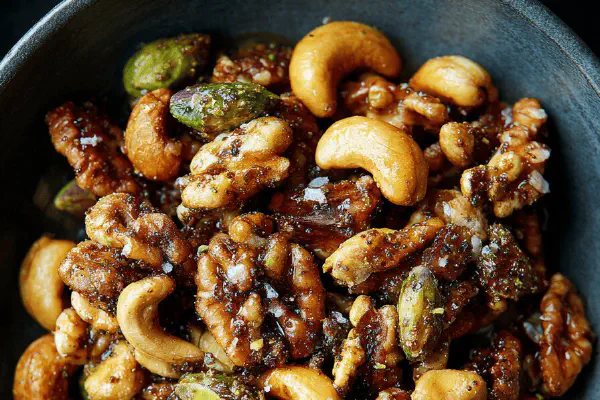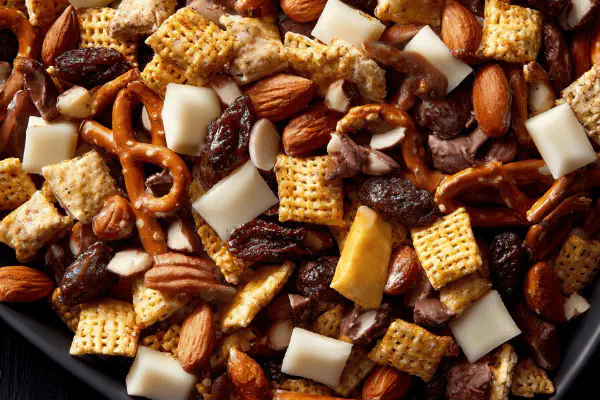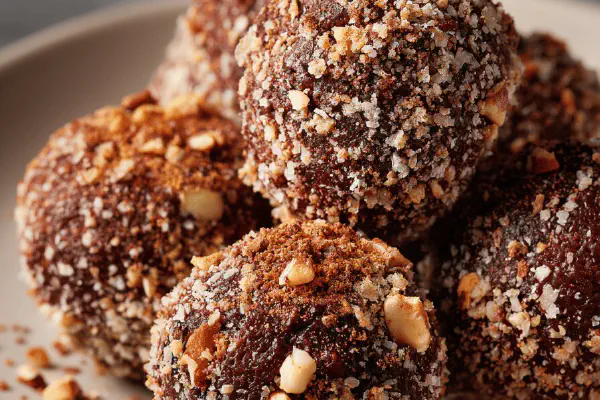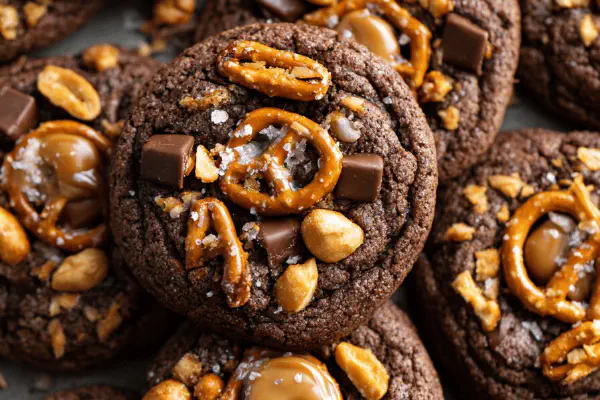Crunchy Peanut Brittle Remix
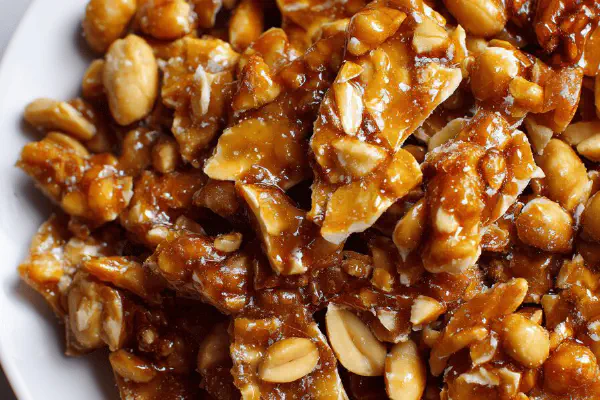
E
By Emma
Certified Culinary Professional
•
Recipe tested & approved
A caramelized peanut brittle with a twist. Sugar and golden syrup cooked till deep amber, where aromas shift from sweet to toasted notes. Peanuts toasted dry replace roasted for a nuttier punch. Baking soda introduced at the last second creates air pockets for light, crackly texture. Maple syrup swapped for corn syrup, a different sweetness layered in. No eggs, dairy, nor gluten. The sheet pan lined with silicone mat, not parchment, to avoid sticking on humid days. Offers bursts of sugary crunch with nutty undertones. Adjust heat based on bubbly sounds and color changes, never by time alone. Break brittle carefully to get varied piece textures—some chunky, some ground fine—for decorating desserts or munching straight up.
Prep:
6 min
Cook:
12 min
Total:
18 min
Servings:
6 servings
#candy
#nuts
#caramel
#brittle
#snack
#peanuts
#corn syrup
#baking soda
Caramel and peanuts. Simple, right? Yet so many trips down brittle lane taught me a few truths. Sugar can betray you—grainy crystals ruin the day, burnt sugar smokes kitchen, or worse sticky patches that never set. Swapping corn syrup for maple syrup isn’t just a swap; it’s a flavor shift, deeper, woodsy background notes that pop unexpectedly when you crack the final candy. Dry roasted peanuts over salted ones avoid salt sabotaging sweet notes. Baking soda foaming creates air and light pockets, a technique I never skip now. Parchment? No. Silicone mats win every time, especially when air humidity wants to ruin all your crunchy efforts. Timing here? Forget minutes. Watch bubbles change, listen to crackling bubbling, smell caramelize. That’s the call for lifting off heat. Quick spread, or brittle sets with hard-to-break edges. Crunch control through variable chunk sizes, for texture narratives on top of other desserts or just yum on their own. Experiment, get messy. Candy making’s a practice, a dance with heat and sugar’s magical chemistry.
Ingredients
- 70 ml (about 1/3 cup) water
- 105 ml (roughly 7 tablespoons) granulated sugar
- 110 ml (just under 1/2 cup) maple syrup
- 160 ml (about 2/3 cup) dry roasted unsalted peanuts
- 3 ml (3/4 teaspoon) baking soda
About the ingredients
Water’s key for initial caramelization lubrication but minimal—too much and the crystal control goes awry. Sugar type? Granulated preferred for even melting; coarse sugar struggles dissolving fast. Maple syrup swapped for corn syrup here—if unavailable, use honey but watch for faster browning. Dry roasted peanuts internal oils pop differently than raw or salted; salt excess kills brittle sweet balance and caramel flavor. Baking soda amount crucial; too much flattens texture, too little no aeration effect, brittle too dense. Silicone mat recommended over parchment; parchment can encourage sticking under humid conditions. A small pastry brush in water reserved for wiping sugar crystal formation is a little labor but saves untold grainy failures. Peppers, cinnamon, or sea salt sprinkle twists can be introduced at last step before cooling for flavor experimentation.
Method
- Start with a clean sheet pan lined with silicone baking mat, not parchment for better release. Set aside.
- In a medium-heavy saucepan, mix water sugar and maple syrup. Stir briefly just to combine, then stop. Bring to medium-high heat, swirling pan occasionally. Watch closely. Tiny bubbles start around edges, clear at first.
- Use a wet pastry brush to wipe down sides constantly. No crystals allowed to form; otherwise, the brittle turns gritty. Heat shifts from clear to pale amber; that’s key—late amber before burning. The smell deepens, hints of caramel toast but not sharp burnt sugar.
- Add peanuts now. Stir once vigorously with wooden spoon. The mixture thickens fast, peanuts coated bright and glossy.
- Cook one minute more. Bubbles grow bigger, crackling sound under the pan faint but steady. Take off heat quickly.
- Stir in baking soda immediately. Mixture foams white, expands, sharp change in texture noticeable.
- Pour fast onto mat. Use an offset spatula scraping hard to spread thin but uneven, edges thinner than center—this creates texture contrast.
- Cool completely at room temp; brittle cracks loudly when tapped.
- Break half into sizable chunks with your hands. Chop rest finely on wooden board with chef’s knife, wide blade rocking gently to avoid shattering glass-fine dust.
- Use chunky shards to decorate chocolate cakes, dust fine bits on top or mix into ice cream. Store brittle airtight; moisture ruins crunch.
Cooking tips
Start medium-high but keep heat manageable. Caramelization stages visible and audible. Early bubbles small and clear, sugar melted sunken. Wipe sides with wet brush nonstop, or risk sugar crystallizing on pot walls, ruin candy texture with gritty shards. Watch color shift like liquid amber. Smell changes—a toasty smell heralds readiness. Add peanuts only once sugar syrup reaches late amber color; early addition risks peanuts soggy, late addition leads to burnt nuts. After peanuts in, stir only for a minute. Off heat, immediate baking soda addition creates foam—don’t skip this or brittle feels too heavy, dull texture. Pour onto mat ASAP before foam collapses. Spread fast but not too thin; edges thinner than center add crunch variation. Cool on countertop without disturbing; refrigeration adds moisture problems and softens brittle. Break pieces strategically—chunky bits for crunch, small crystals to dust. Store in sealed containers away from moisture. If brittle sticks, warm gently to reset texture gently, avoiding full reheat collapse. Practical tricks: use heavy-bottom pan for even heat, wooden spoon avoids scratching and resists overheating, avoid stirring sugar syrup during cooking to prevent crystallization.
Chef's notes
- 💡 Watch bubbles not time. Tiny clear bubbles first. Then bigger crackle bubbles. That’s your signal for heat changes. Trust smell changes too caramel not burnt sugar aroma tells when to move fast.
- 💡 Wipe saucepan sides constantly with wet pastry brush. Crystals form quick and turn brittle gritty grainy. Don’t skip this or get that rough brittle texture you hate. Small task prevents big fail.
- 💡 Add peanuts only when syrup hits late amber color. Early and peanuts soggy. Late and nuts burn bitter. Timing is key. Stir vigorously once so peanuts coat evenly but don’t overmix or mash.
- 💡 Baking soda adds foam and air pockets. Add off heat immediately or no lift, dense brittle. Foam collapses fast so pour quickly onto silicone mat avoid parchment here humid days cause sticking.
- 💡 Spread mixture thin but uneven. Edges thinner than center adds crunch contrast. Cooling on room temp, no fridge. Refrigeration adds moisture ruins crunch. Break brittle into chunks and dust fine pieces for texture variety.
Common questions
Why baking soda?
Creates foam, air pockets inside brittle. Makes texture lighter, crackly. Add off heat right away or no effect. Too much flattens texture, too little dense candy.
Substitute for corn syrup?
Maple syrup used here but tends to brown faster. Honey can work but watch closely for burning. Each swap changes sugar chemistry and cooking time slightly.
Brittles sticks or soggy?
Moisture kills crunch. Use silicone mat not parchment, especially in humid conditions. Store airtight. Warm brittle gently if sticky but don’t reheat hard or lose foam texture.
Can I use salted or raw peanuts?
Salted risks throwing brittle balance salty-sweet. Raw lacks toasted nutty flavor and oil release changes caramel flavor. Dry roasted best for consistent results and crunch.
